Toxic Treated Fracked Waste Water Includes Beneficial Use under HB 546
Under the New Mexico constitution beneficial use is the basis, the measure and the limit of the right to use water; therefore, beneficial use of public water diverted or impounded by manmade works is an essential element in the development of a water right. HB 546 has made fracking toxic contaminants a water right.
When questioned the NM State Engineer John D’Antonio the Albuquerque Information Meeting on the rule making in October 2019 the State Engineer remained silent and ignored the question.
Signed into law July 1st 2019 without a transparent public vetting for health and toxic impacts to environment.
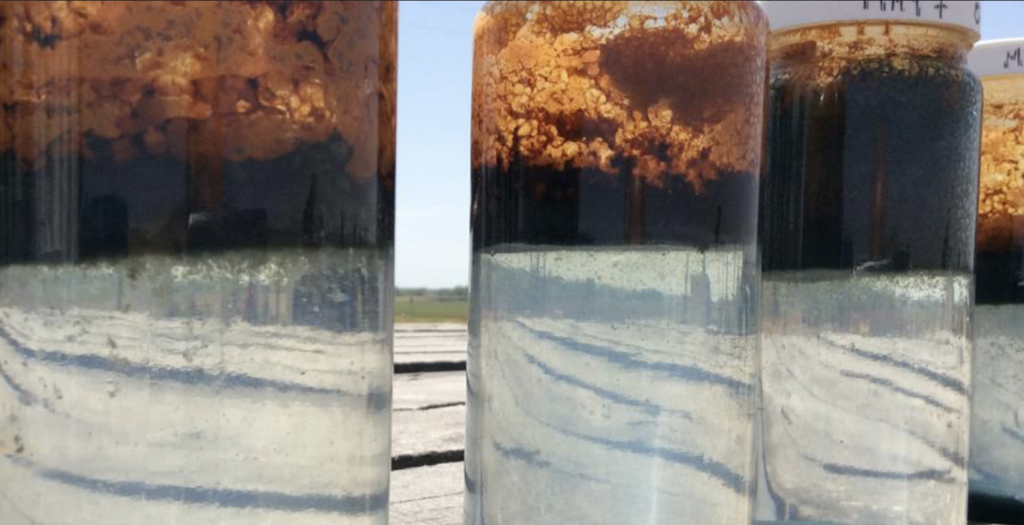
NMED is holding Informational Meetings to hear public comments prior to rule making. The rules will be written privately, then to a public commenting period will take place before it goes before the Water Quality Control Commission (WQCC). There has been no timeline confirmed. Nor has NMED informed the public on how recent rule changes will impact their ability to regulated on produced water. The State entered with an MOU with NMSU in a $100 Million Consortium paid for by the oil and gas industry to research produced water. This is largest research grant in the country and is not independent from the oil and gas industry. The State is doing the bidding for the Industry. This Bill was passed without allowing ;public transparency or input on the science that shows what is happening in other states with food security, environmental impact and health issues rising from the ”beneficial use’ of fracking treated WASTEWATER use on crops, for road spreading and livestock.
HB 546 BECAME LAW JULY 1, 2019 — It was the fastest pass in state legislative history and we believe it violated the Open Meetings Act. State Rep Small and others would not allow us into the room to discuss the concerns and to delay the bill. Announced to the House floor 30 sec at the end of the Friday/Saturday early morning session. Rep Nathan Small and the House Speaker conspired on the announcement. Video was not posted until after the 8 am meeting nor would Small or his office tell us where the conference meeting has being held. He was able to do with the help of the Sierra Club, CVNM, EDF, NRDC, in order to give O&G a win for Congresswoman Small and her husband. We are now considering charges before the Ethics Commissions on the behavior of Rep Small and House Speaker Egolf, who had total disregard for human health impacts and refused to hear constituents of the state of NM.
ENVIRONMENTAL JUSTICE ISSUES ON PRODUCED WATER USE
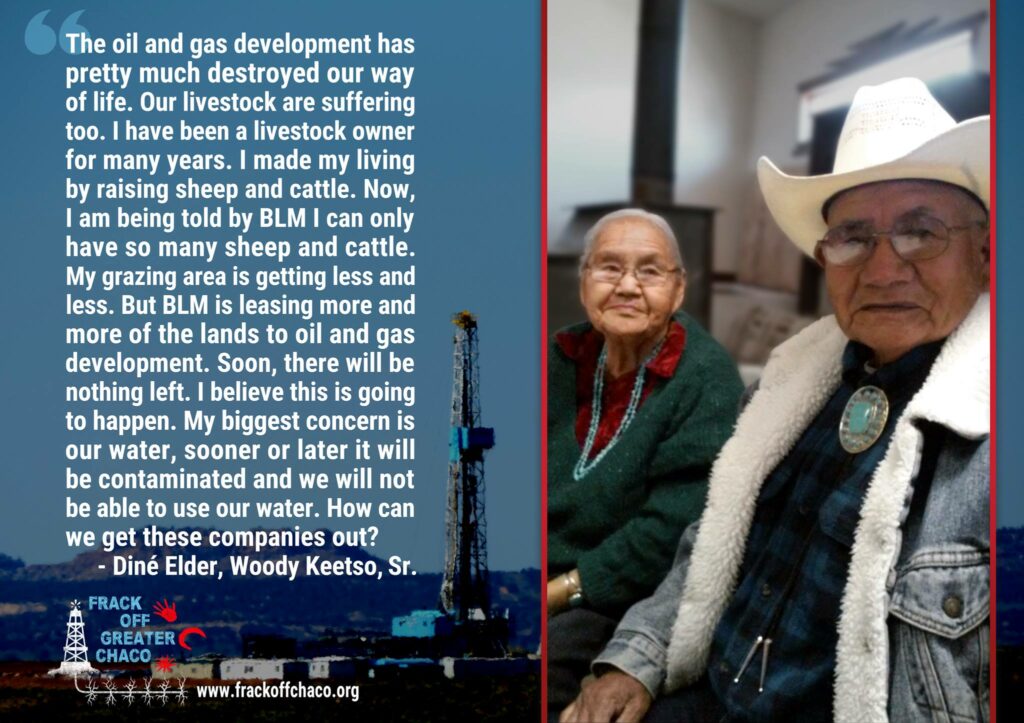
Fracking can be considered an environmental justice issue as many drilling sites are located in poor and rural communities. Although gas companies may not specifically target these companies because they expect limited political resistance, often times there is more room to work in rural areas and wealthier people are less inclined to lease their mineral rights. In a study on the placement of unconventional gas wells in three counties near Pittsburgh, it was found that 777 out of 779 wells were located in areas with a median home value below $200,000.[vi] Similarly, in the Marcellus Shale Pennsylvania region, researchers from Clark University found a strong correlation between active fracking wells and poverty levels. In fact, in seven out of nine analyses, fracked tracts had a significantly higher percentage of people below the poverty line as compared to tracts that were not exposed.[vii] Chemicals in drinking water, radon, and sulfur dioxide have all been found near natural gas sites in the Marcellus Shale area.¡Environmental and health consequences in exchange for increased economic activity has been a recurring theme in the fracking debate. However, the profits do not fairly benefit the communities where the fracking sites are located. As innovative renewable technologies develop, the cost of green energy will continue to go down and be able to provide more energy to our growing world, providing a superior alternative to fracking

NEW MEXICO IS RANKED 37TH IN THE COUNTRY FOR OVERALL HEALTH AND OFTEN HAS SOME OF THE WORST RANKINGS FOR SOCIAL INDICATORS OF HEALTH, INCLUDING RATES HIGHER THAN THE NATIONAL AVERAGE FOR POVERTY, LOW FOOD ACCESS, AND FOOD INSECURITY.
Full assessment: Presbyterian’s 2016 Community Health Needs Assessment for Central New Mexico
CALIFORNIA PRODUCED WATER CONTAMINATION
WHAT THE STATE DID NOT DO TO PROTECT RESIDENTS AND THE ENVIRONMENT
CENTRAL VALLEY’S GROWING CONCERN: CROPS RAISED WITH OIL FIELD WATER
Oil field water: In the May 3 Section A, of the LA Times, an article about the use of recycled oil field water in California agriculture said that samples contained acetone and methylene chloride after treatment. Acetone was found in testing in 2014, but not in a March 2015 test. An accompanying graphic cited the levels of three chemicals found in untreated oil field water: oil, 240,000-480,000 parts per million; acetone, 440-530 parts per billion; and methylene chloride, 82-89 parts per billion. However, the graphic omitted the levels found in tests of treated water: oil, 130-1,300 parts per million; acetone, 57-79 parts per billion; and methylene chloride, 26-56 parts per billion. Also, the source of the untreated water was misidentified. The samples were from the Poso Creek Oil Field, not an oil field owned by Chevron. And Blake Sanden was identified as an agriculture extension agent for UC Davis. Sanden works for the statewide UC Agriculture and Natural Resources program. —
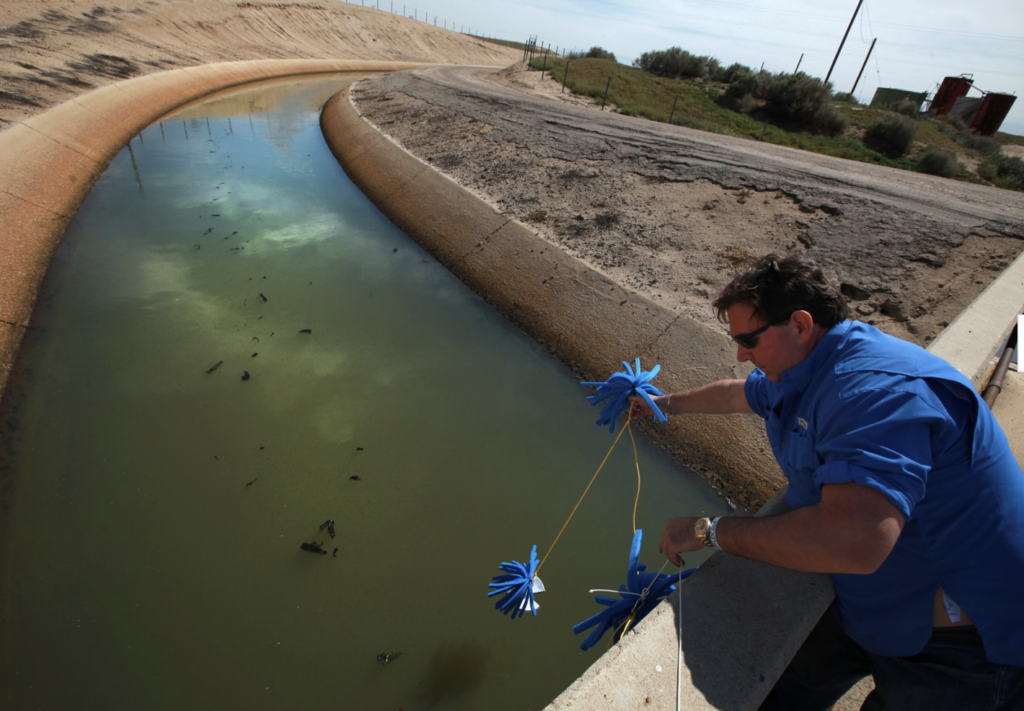
————
Until now, government authorities have only required limited testing of recycled irrigation water, checking for naturally occurring toxins such as salts and arsenic, using decades-old monitoring standards. They haven’t screened for the range of chemicals used in modern oil production. LA TIMES ARTICLE BY JULIE CART MAY 2, 2015
AGRICULTURAL AND OIL AND GAS INDUSTRIES COMPETE FOR WATER
Oil and gas production is concentrated in arid areas of the state, where it may compete for water with agricultural, municipal, or domestic water users. Further, pollution due to spills, leaks, or disposal of oil-field wastes can contaminate the soil and water resources used by agriculture. There is also growing interest among commercial irrigators and water managers in reusing oil-field wastewater for agriculture and food production.

Coppock, and Zinn 1979).
Common Ground Rising has compiled information from scientific and health peer-reviewed studies that has been known, since 2015 to present, which was not included in briefing to legislature prior to passage.
The following Findings and resolutions are based on the Pacific Institute Food, Water and Oil report in 2015
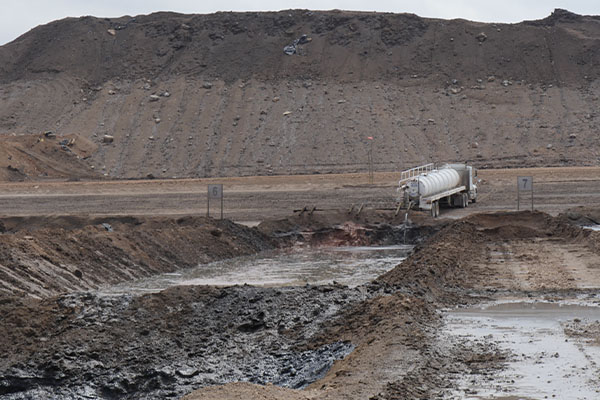
Photo Credit: Melissa Troutman – Hobbs NM. June 2019 Dumping produced water in unlined pits there is little enforcement and fines given in NM oil and gas industry is allowed to operate with impunity because there is little political will to stop this environmental exploitation.
Finding 1:
The disposal of oil-field wastewater in unlined percolation pits poses a significant risk of contaminating groundwater resources that may, in turn, be used by agriculture. While this practice has been banned in several states. IN 2008 NM banned the use of unlined pit for disposal of oil and gas waste water. Even lined pits leak. POTENTIAL RISKS FROM BENEFICIAL USE (Pavley & Wieckowski 2015), (Cart 2015b), (Ross 2015; Geiling 2015).
- Recommendations: Pits that are no longer in use can contaminate soil and groundwater when rain or irrigation water seeps through surface layers and carries pollutants into shallower groundwater NM should phase out pits, or impoundment storage
- The state should require cleanup of existing sites, where necessary, and require long-term monitoring of pollution that may migrate in groundwater.
Finding 2
- There are serious deficiencies in the way regulates underground injection of oil and gas wastewater. In particular, wastewater has been injected in potential underground sources of drinking water, irrigation water, and water for livestock.
- Recommendations 2(a): The state should require oil companies to clean up contamination from injection wells that have failed.
- 2(b): Regulators should revisit old injection permits that were issued without an appropriate “area of review” calculation to determine the zone that would be affected by injection wells. (NM OCD 2007)
- 2(c): Given the potential to desalinate brackish groundwater to provide for agriculture and community water needs, policymakers should consider imposing more protective standards for brackish water above the federal requirement that requires protecting aquifers with total dissolved solids (TDS) of up to 10,000 (NMED) parts per million. WQCC revised regulations in 2018 they deleted human health impacts.
Findings 3 (CCST, LBNL, and Pacific Institute 2014).
- Hundreds of chemicals are used in or produced from oil and gas exploration and production, many of which are harmful or have an unknown effect on livestock, crops, and farmworkers.
- Recommendations 3(a): Where exposure pathways to humans or sensitive environments exist, oil and gas companies should eliminate or seek to minimize the use of hazardous chemicals that do not biodegrade or otherwise become immobilized.
- 3(b): The state should require oil and gas operators to disclose all chemicals that are injected into wells, including during drilling, well cleanout and maintenance, hydraulic fracturing, acid stimulation, and enhanced oil recovery.
- 3(c): State regulators should limit or eliminate the use of chemicals with suspected but unknown health impacts pending further study. The State should include impacts that the Compendium 6 with over 1800 peer reviewed studies have brought forth. ¡Recommendation
- 3(d): The chemical and petroleum industries should fund through impact fees and fines independent scientific studies to increase understanding of the health and environmental impacts of those chemicals whose impacts are not known, especially those that remain in waters after hydraulic fracturing and other oil-field operations. Priority research should focus on a handful of chemicals in produced water with known or suspected health impacts and should study their uptake in food crops to determine whether there are pathways by which people are exposed to dangerous chemicals in the food they consume. Until the health and environmental impact of a chemical is understood, state oil and gas regulators should not allow its use.
- 3 (e): Rescind the state legislation on State Engineer Exemption Brine under 2500 ft. This rule NMSA 1978 : 72:12;26, SB-1169 ¡Recommendation 3 (f): Rescind the state Legislation on Radium Exemption This rule was filed as 20 NMAC 3.1 Subpart 14.
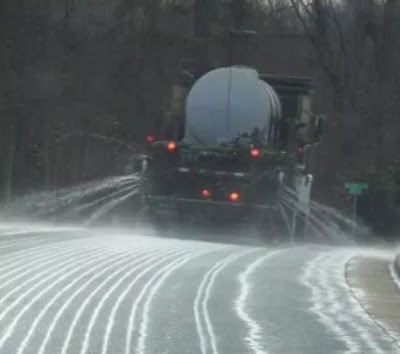
Photo Credit: Chris Northrup Courtesy Earthworks Oil and Gas Accountability Project No. WQCC 17-03 (R) April 23 2018 WQCC amended the regs and deleted human health protections
Finding 4:
- (Schlanger 2015).Federal regulations for toxic chemicals and waste handling are outdated and inadequate to protect human health, the environment, and the safety of our food supply.
- Recommendations 4(a): Congress should pass meaningful reform of the Toxic Substances Control Act of 1976, the main federal law regulating the use of chemicals. Meaningful reforms would make more information available on the environmental and health effects of chemicals used by industry, including oil and gas exploration, and support the use of safer chemicals.
- 4(b): Congress should amend the Resource Conservation and Recovery Act to end the exemptions for oil-field wastes from being regulated as toxic chemicals. Most oil-field wastes contain hazardous chemicals as defined in the Act and regulating them as such would help ensure their safe handling and disposal.
- 4(c): Congress should close the loophole in the Safe Drinking Water Act that exempts hydraulic fracturing chemicals from the regulation under the Act. This would allow state and federal governments to regulate these chemicals where they may affect drinking water
- 4(d): Congress should pass federal legislation clarifying the ability of the Bureau of Land Management (BLM) to regulate hydraulic fracturing on federally-owned lands.
Finding 5:
Idle, orphaned, and abandoned wells can allow oil, wastes, and chemicals to move into soil and groundwater, posing a largely hidden threat in agricultural regions near or overlapping with oil and gas production.
- Recommendations 5(a): To prevent contamination of near-surface groundwater resources, the state should ensure that idle wells are closed down and sealed properly.
- 5(b): Regulators should examine whether current bonding requirements are sufficient to cover the costs of well closure and any cleanup of contamination caused by abandoned or orphaned wells.
- 5(c): The legislature should ensure that impact fees on oil and gas production are sufficient to fund the closure of orphaned wells and cover other costs of programs to mitigate air and water pollution caused by the industry.
- 5(d): The state should conduct an assessment of the over 116,000 plugged and abandoned oil and gas wells to determine which of these, if any, pose a risk to freshwater aquifers, and take appropriate steps to alleviate the threat of contamination.
- (CCST and LBNL 2015b, II:122–123). (Esser et al. 2015).(GAO 1989).(DOGGR 2015).
Finding 6:
- There is growing potential for competition for water between oil and gas companies and farming communities, and concern that the use of this water by the oil industry will drive up the price that farmers pay for irrigation water.
- Recommendations 6(a): Oil and gas companies should reduce or eliminate their use of freshwater that could otherwise be put to agricultural For municipal uses. Companies can do this by increasing the amount of water that they treat and recycle onsite, or by using recycled wastewater from cities or other industries.
- Recommendation 6(b): The legislature can support this by declaring that freshwater use for oil and gas production does not constitute a “reasonable use” where recycled water use is available. Similar legislation was passed in 2010, declaring the use of potable water for landscape irrigation as a waste or unreasonable use of water if recycled water is available. 19
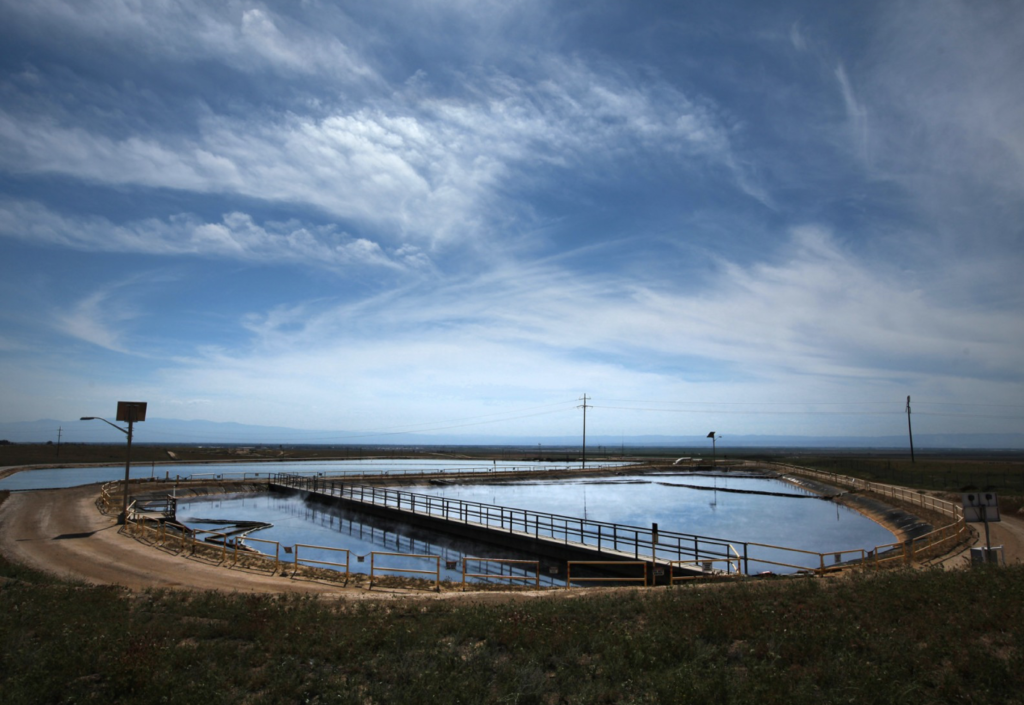
Photo credit: Brian van der Berg May 2, 2015 for LA Times
Finding 7:
- EXPANDING the recycling of oil-field wastewater for “beneficial uses,” such as for crop irrigation or livestock watering COMES WITH RISKS. However, the health and food safety impacts of this practice are poorly understood.
- Recommendations 7(a): The state should develop a uniform set of guidelines for the reuse of oil and gas wastewater, similar to the Title 22 regulations for the reuse of treated sewage. This should include commissioning an independent scientific study to determine what level, if any, of chemicals in oilfield wastes are safe for farmworkers, animals, and consumers. This study could help identify any health or environmental issues associated with this practice, establish clear guidelines for water treatment and testing, and help reduce the fear, uncertainty, and doubt that currently surround the practice.
- Recommendation 7(b): An independent scientific assessment of the safety of oil-field wastewater should include an assessment of whether contaminants can bioaccumulate in meat, eggs, or dairy products, and what the possible health impacts of this are. A useful parallel can be seen in the methods used by the FDA and NOAA to test seafood following oil spills, for example the 2010 Deepwater Horizon accident in the Gulf of Mexico. This risk-based approach is based on limiting consumption to levels that avoid cancers and chronic health effects.
- Recommendation 7(c): The state should establish uniform and science-based water quality criteria and monitoring requirements. Regional water boards should not issue new permits for the reuse of oil-field wastewater for irrigation until the risks have been comprehensively assessed and appropriate monitoring and reporting requirements put in place. Water quality criteria and monitoring requirements should be designed to protect farmworkers as well as consumers.
- Recommendation 7(d): Oil companies that provide water for irrigation should be required to provide a list of all chemicals used in the drilling, stimulation (if applicable), maintenance, and production process in oil fields to their State and Regional Board and the water utility. This step that should be implemented.
Finding 8:
- Pollution from past oil and gas exploration and production and waste disposal exist in the soil and groundwater throughout the state, often very near or upstream from agriculture. The full extent of “legacy pollution” is poorly understood.
- Recommendations 8(a): Oil and gas companies should be required to conduct testing and remediation of soil in areas where drilling mud disposal has occurred. ¡
- Recommendation 8(b): Industry and water quality regulators should catalog and map the locations of drilling mud disposal areas and make this information publicly available, so that farmers are aware of the potential risk when deciding to farm that land or utilize local groundwater.
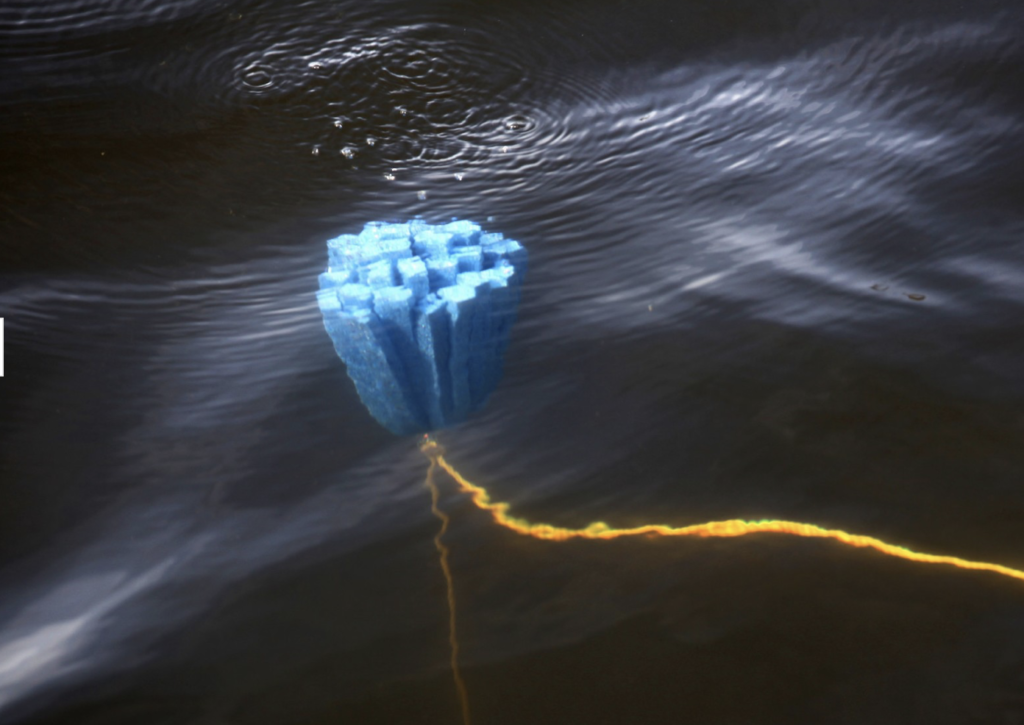
https://www.latimes.com/local/california/la-me-drought-oil-water-20150503-story.html
Finding 9:
- Missing and inaccurate data prevent better understanding the fate of oil-field wastes. In their submissions to DOGGR, oil and gas companies reported the disposal method for 18% of oil and gas wastewater (over 25 million gallons) as other, missing, or unknown
- Recommendation 9(a): DOGGR should better verify the data submitted by oil and gas companies on wastewater handling and its disposition to ensure that it is complete and accurate. These data should be expanded to include details on water recycling and beneficial reuse.
- NMED shows DOGGR as a safe standard on Information on produced water webpage and it is not according to Pacific Institute report findings.
Finding 10:
- In areas where agriculture and oil production overlap, farmworkers are among the most vulnerable to the health effects of air and water pollution.
- Recommendations 10(a): In areas where farmworkers may be exposed to oil-field wastes in air, soil, or water, regulators should analyze the associated health risks and, if important exposure pathways are found, identify how to avoid or lessen workplace exposures. In particular, regulators should do more to measure and enforce air quality limits on volatile compounds that can contribute to asthma and respiratory problems.
- Recommendation 10(b): The Division of Occupational Safety and Health (NM/OSHA) should require employers to analyze potential chemical hazards and communicate these hazards to employees. Such an analysis could reassure farmworkers if it revealed there were no health or safety concerns or lead to new regulatory protections if hazards are identified.
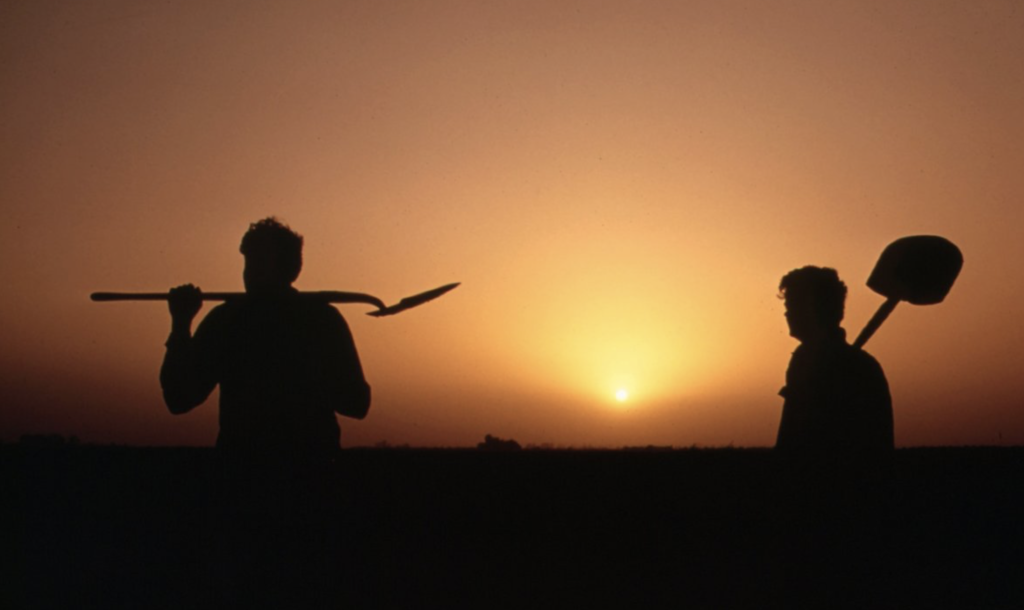
Assessment Conclusions on Fracking WasteWater Impacts on Agriculture
- We conclude that oil and gas production present many challenges for New Mexico agriculture. One of the major concerns is the potential threat of air, soil, and water contamination and resulting impacts on the food supply, soil quality, and farmworkers. Hundreds of chemicals are used in or produced from oil and gas exploration and production.¡
- Many of these chemicals are known to be harmful or have unknown effects on livestock, and crops, as well as farmworkers, who are among the most vulnerable to the health effects of air and water pollution. Inadequate or unsafe waste disposal methods, accidental spills and leaks, and illegal dumping can release these chemicals into the environment. Regulations for toxic chemicals and waste handling are outdated and inadequate to protect human health, the environment, and the safety of our food supply.¡
- The disposal of oil-field wastewater is a particular concern for agriculture. Disposal in unlined percolation pits poses a significant risk of contaminating groundwater resources that may, in turn, be used by agriculture. While this practice has been banned in several states, in 2008 it is was outlawed in New Mexico BUT LAWS NOT ENFORCED. There are also serious deficiencies in the way New Mexico regulates underground injection of oil and gas wastewater. In particular, wastewater has been injected in potential underground sources of drinking water, irrigation water, and water for livestock. In addition, idle, orphaned, and abandoned wells can allow oil, wastes, and chemicals to move into soil and groundwater, posing a largely hidden threat to surrounding agricultural areas.¡
- There is growing concern that the use of freshwater by the oil industry will reduce the amount available for agriculture or drive up the price that farmers pay for water. On the other hand, wastewater from oil and gas production appears as a new source of water for crop irrigation or livestock watering. Reuse of wastewater (including oil-field wastewater) for beneficial purposes is currently being regulated in NM. While recycled oil-field wastewater may be seen as an extremely valuable supply to growers in water short regions, it is not likely to fulfill a significant percentage of the state’s irrigation needs. NOR SHOULD IT Moreover, the health and food safety impacts of this practice are poorly understood, and the current regulatory system for using recycled oil-field wastewater for irrigation is insufficient to protect our agricultural lands, farmworkers, and the food supply. It is that way in California and New Mexico will not be an exception. ¡
- There is a fundamental lack of information about oil and gas production activities in New Mexico that precludes adequate risk management by and for nearby farms. More data and information are needed to protect human health, the environment, and New Mexico’s agricultural industry. This is why we proposed Senate 459 to call for the studies of these issues to make a viable plan and legislation that regulates state agencies and enforcement. ¡
- While the state of New Mexico has set ambitious goals for increasing renewable energy supplies, to meet our energy needs for decades to come. With this in mind, oil industry wastes need to be more carefully managed to protect the state’s land, water resources and human health. Produced water should be reused inside the industry only with no use outside of it.¡
- Finally, changes to programs and policies can make oil and gas exploration and production safer for New Mexico’s food and agricultural systems, and protect the health and safety of everyone from farmworkers to consumers.
Citations and References
Ansolabehere, David. 2015. General Manager, Cawelo Water District. Personal communication.
Arora, Monu, Bala Kiran, Shweta Rani, Anchal Rani, Barinder Kaur, and Neeraj Mittal. 2008. “Heavy Metal
Accumulation in Vegetables Irrigated with Water from Different Sources.” Food Chemistry 111 (4): 811–15.
doi:10.1016/j.foodchem.2008.04.049.
Baker, David R. 2013. “California Oil Production Rises Slightly.” San Francisco Chronicle, February 27.http://www.sfgate.com/business/article/California-oil-production-rises-slightly-4314836.php.
Bamberger, Michelle, and Robert E. Oswald. 2014. “Unconventional Oil and Gas Extraction and Animal Health.”Environmental Science: Processes & Impacts 16 (8): 1860. doi:10.1039/C4EM00150H.
Belridge Water Storage District. 2012. “Section III: Description of Quantity of Water Uses. 2012 Agricultural WaterManagement Plan.” http://www.belridgewsd.com/wp-content/uploads/2013/08/5.-Section-III.-Descriptionof-Quanity-of-Water-Uses.pdf.
Bergman, .ke, Jerrold J. Heindel, Susan Jobling, Karen A. Kidd, and R. Thomas Zoeller, eds. 2013. State of the Science of Endocrine Disrupting Chemicals – 2012. United Nations Environment Programme and the WorldHealth Organization. http://www.who.int/ceh/publications/endocrine/en/.
Borrell, Brendan. 2009. “Are Proposition 65 Warnings Healthful or Hurtful?” Los Angeles Times, November 2.
California Council on Science & Technology, and Lawrence Berkeley National Laboratory (CCST and LBNL).
2015a. An Independent Scientific Assessment of Well Stimulation in California, Volume I: Well Stimulation Technologies and Their Past, Present, and Potential Future Use in California. Vol. I. Sacramento, California.
http://ccst.us/projects/hydraulic_fracturing_public/SB4.php.
———. 2015b. An Independent Scientific Assessment of Well Stimulation in California, Volume II: Potential
Environmental Impacts of Hydraulic Fracturing and Acid Stimulations. Vol. II. Sacramento, California.
http://ccst.us/projects/hydraulic_fracturing_public/SB4.php.
California Council on Science & Technology, Lawrence Berkeley National Laboratory, and Pacific Institute (CCST,
LBNL and Pacific Institute). 2014. “Advanced Well Stimulation Technologies in California: An Independent
Review of Scientific and Technical Information.” http://ccst.us/projects/hydraulic_fracturing_public/BLM.php.
California Department of Food and Agriculture. 2014. “California Agricultural Production Statistics.”California Natural Resources Agency. 2014. “California Water Action Plan.” Sacramento.
http://www.cdfa.ca.gov/statistics/.
http://resources.ca.gov/california_water_action_plan/.
http://www.latimes.com/health/la-he-pro-con2-2009nov02-story.html.
http://www.latimes.com/health/la-he-pro-con2-2009nov02-story.html.
Carls, Keith. 2015. “Big Turnout for Oil Field Aquifer Exemption Hearing.” KEYT, September 21.http://www.keyt.com/news/big-turnout-for-oil-field-aquifer-exemption-hearing/35407102.
Cart, Julie. 2015a. “Central Valley’s Growing Concern: Crops Raised with Oil Field Water.” Los Angeles Times,
May 2. http://www.latimes.com/local/california/la-me-drought-oil-water-20150503-story.html.
———. 2015b. “Potentially Harmful Chemicals Found in Oil Field Water Used for Irrigation.” Los Angeles Times,
June 20. http://www.latimes.com/local/california/la-me-oil-water-tests-20150620-story.html.
California Energy Commission (CEC). 2015. “Staff Workshop Potential Effects of Land Subsidence to Natural Gas& Oil Infrastructure in the Central Valley, California.” http://www.energy.ca.gov/calendar/?eID=2510.
Center for Biological Diversity. 2013. “Water Board Ends Waiver That Allowed Unregulated Dumping of ToxicDrilling Muds in California’s Central Valley.” December 5.http://www.biologicaldiversity.org/news/press_releases/2013/oil-and-gas-drilling-12-05-2013.html.
Center for Food Safety and Applied Nutrition (CFSAN). 2015. “Research Strategic Plan.” March .http://www.fda.gov/Food/FoodScienceResearch/ResearchStrategicPlan/default.htm.
Central California Irrigation District. 2014. “Updated Water Supply Rates and Allocations.”http://www.ccidwater.org/Allocations%202-3-14.pdf.
Central Coast Regional Water Quality Control Board (CCRWQCB). 2005. “Chevron San Ardo WDR R3-2005-0070.”———. 2013. “Order No. R3-2013-0029, NPDES No. CA0050628.” http://www.waterboards.ca.gov/centralcoast/board_decisions/adopted_orders/2013/2013_0029_freeport_npdes_permit.pdf.
Cernansky, Rachel. 2012. “Proposed Law Would Keep California Farmworkers from Overheating.” Grist, May 10.http://grist.org/industrial-agriculture/worker-safety-act/.
Chevron. 2013. Producing Energy and Oranges.http://www.chevron.com/stories/#/allstories/energyandoranges/.
Conlan, Michelle, and Brian Grow. 2013. “They Own the House, but Not What Lies Beneath.” Reuters.http://graphics.thomsonreuters.com/13/10/USA-FRACKING:RIGHTS.pdf.
Cooper, Robert C., Adam W. Olivieri, Michael D. Cahn, John Colford, James Crook, Jean-Fran.ois Debroux,Robert Mandrell, Trevor Suslow, and George Tchobanoglous. 2012. “Review of California’s Water Recycling
Criteria for Agricultural Irrigation.” Fountain Valley, California: National Water Research Institute. http://www.waterboards.ca.gov/drinking_water/certlic/drinkingwater/documents/recharge/NWRI_AgPanelReportforCDPHFINAL-09-2012.pdf.
Cox, John. 2011. “Oil Production Straining Ties with Ag.” The Bakersfield Californian, June 10.http://www.bakersfield.com/news/2011/06/10/oil-production-straining-ties-with-ag.html.
———. 2014. “Farmer Lawsuit Blames Crop Loss on Oil Companies’ Waste Injections.” The Bakersfield
Californian, September 16. http://www.bakersfield.com/blogs/2014/09/17/farmer-lawsuit-blames-crop-losson-oil-companies-waste-injections.html.
———. 2015a. “Summit Examines Pain in Oil, Ag, Related Industries.” The Bakersfield Californian, March 25.
———. 2015b. “Debate Over State Oil Severance Tax Continues.” The Bakersfield Californian, May 24.http://www.bakersfield.com/news/2014/05/25/debate-over-state-oil-severance-tax-continues.html.
———. 2015c. “County Planning Commission Recommends Approval of Oil and Gas Permitting Initiative.”
The Bakersfield Californian, October 5. http://www.bakersfield.com/news/2015/10/05/county-planningcommission-recommends-approval-of-oil-and-gas-permitting-initiative.html.
Central Valley Regional Water Quality Control Board (CVRWQCB). 2004. “Water Quality Control Plan for the Tulare Lake Basin Second Edition.”http://www.waterboards.ca.gov/centralvalley/water_issues/basin_plans/tlbp.pdf.
———. 2012. “Order No. R5-2012-0058: Waste Discharge Requirements for Chevron U.S.A. Inc. and Cawelo Water District Produced Water Reclamation Project.” http://www.waterboards.ca.gov/centralvalley/board_decisions/adopted_orders/kern/r5-2012-0058.pdf.
———. 2013. “Settlement Agreement Reached with Kern County Oil Firm for Discharging Hydraulic Fracturing Fluid.” http://www.swrcb.ca.gov/press_room/press_releases/2013/pr111513.pdf.
———. 2014. “Settlement Agreement and Stipulation for Entry of Administrative Civil Liability Order R5-2013-0587 in the Matter of Vintage Production California LLC Kern County.” http://www.waterboards.ca.gov/centralvalley/board_decisions/adopted_orders/kern/r5-2014-0536.pdf.
———. 2015. “Oil, Gas & Geothermal – Idle and Orphan Well Program.” Accessed October 23.http://www.conservation.ca.gov/dog/idle_well.
Drouin, Roger. 2014. “Fracking the Farm: Scientists Worry About Chemical Exposure to Livestock and Agriculture.” Truthout, August 3. http://www.truth-out.org/news/item/25216-fracking-the-farm-scientists- worry-about-chemical-exposure-to-livestock-and-agriculture.
Dube, A., R. Zbytniewski, T. Kowalkowski, E. Cukrowska, and B. Buszewski. 2001. “Adsorption and Migration of Heavy Metals in Soil.” Polish Journal of Environmental Studies 10 (1): 1–10.
Dusseault, Maurice B., Michael S. Bruno, and John Barrera. 2001. “Casing Shear: Causes, Cases, Cures.” SPE Drilling and Completion, no. June: 98–107.
Department of Water Resources (DWR). 2003. “California’s Groundwater.” Bulletin 118, Update 2003. Sacramento: California. http://www.water.ca.gov/groundwater/bulletin118/index.cfm.
———. 2015. “Draft List of Critically Overdrafted Basins.” http://www.water.ca.gov/groundwater/sgm/pdfs/Draft%20COD%20Basins%20short%20Table.pdf.
Earthworks. 2008. “New Mexico Pit Rule.” https://www.earthworksaction.org/issues/detail/new_mexico_pit_rule#.VhrhMCuVkZw.
Edwards, W. C., R. W. Coppock, and L. L. Zinn. 1979. “Toxicoses Related to the Petroleum Industry.” Veterinary and Human Toxicology 21 (5): 328–37.
Esser, Bradley K., Harry R. Beller, Susan A. Carroll, John A. Cherry, Jan Gillespie, Robert B. Jackson, Preston D. Jordan, et al. 2015. “Recommendations on Model Criteria for Groundwater Sampling, Testing, and Monitoring of Oil and Gas Development in California.” LLNL-TR-669645. Livermore, California: Lawrence Livermore National Laboratory. http://www.waterboards.ca.gov/water_issues/programs/groundwater/sb4/docs/ llnl_recommendations_report.pdf.
Environmental Working Group (EWG). 2009. “Free Pass for Oil and Gas.” http://www.ewg.org/research/free-pass-oil-and-gas/oil-and-gas-industry-exemptions.
Farr, Tom G., Cathleen Jones, and Zhen Liu. 2015. “Progress Report: Subsidence in the Central Valley, California.” NASA Jet Propulsion Laboratory and California Institute of Technology. http://water.ca.gov/groundwater/docs/NASA_REPORT.pdf.
Food and Drug Administration (FDA). 2014. “Chemical Contaminants.” http://www.fda.gov/Food/FoodborneIllnessContaminants/ChemicalContaminants/.
Flesher, John. 2015. “Drilling Boom Means More Harmful Waste Spills.” Associated Press, September 8.
http://bigstory.ap.org/article/41f9a423f0124cb3aca3a83fa1f318f6/drilling-boom-brings-rising-numberharmful- waste-spills.
Frantz, Tom. 2015. Kern County resident and almond farmer. Personal communication.
Freeman, Catharine. 2010. “Liquid Assets: Improving Management of the State’s Groundwater Resources.” Sacramento, California: California Legislative Analysts’ Office. http://www.grac.org/laobrief.pdf.
Galbraith, Kate. 2013. “Fracking Increase Spurs Fears Over Water Use.” The Texas Tribune, March 8. http://www.texastribune.org/2013/03/08/texas-water-use-fracking-stirs-concerns/.
Galloway, Devin, David R. Jones, and S. E. Ingebritsen. 1999. “Land Subsidence in the United States.” Circular 1182. Reston, Virginia: US Geological Survey. http://pubs.usgs.gov/circ/circ1182/.
Government Accountability Office (GAO). 1989. “Safeguards Are Not Preventing Contamination From Injected Oil and Gas Wastes.” GAO/RCED-89-97. Washington, DC.
https://assets.documentcloud.org/documents/371047/gao-1989-uic-safeguards-are-not-preventing.pdf.
Duggan, Tara. 2015. “California Poised to Be 1st State to Outlaw Human Antibiotics in Livestock.” San Francisco Chronicle, October 7.http://www.sfchronicle.com/food/article/California-poised-to-pioneer-strict-limit-on-6557430.php
Gautier, Donald L., and Kenneth I. Takahashi. 2007. “A Brief History of Oil and Gas Exploration in the Southern San Joaquin Valley of California.” In Petroleum Systems and Geologic Assessment of Oil and Gas in the San
Joaquin Basin Province, California, edited by Allegra H. Scheirer. Professional Paper 1713. US Geological Survey. http://pubs.usgs.gov/pp/pp1713/03/pp1713_ch03.pdf.
Gas Drilling Awareness for Cortland County. 2015. “Agricultural Impact: Impact of Oil/Gas Drilling on Agriculture.”http://gdacc.org/resources/agricultural-impact/.
Geiling, Natasha. 2015. “California Farmers Are Watering Their Crops with Oil Wastewater, and No One Knows
What’s in It.” ThinkProgress, May 5. http://thinkprogress.org/climate/2015/05/05/3654388/california-drought-oil-wastewater-agriculture/.
Gomez, J. Alfredo. 2014. “Drinking Water: EPA Program to Protect Underground Sources from Injection of Fluids Associated with Oil and Gas Production Needs Improvement.” GAO-14-555. Washington, DC: US Government Accountability Office. http://www.gao.gov/products/GAO-14-555.
Grinberg, Andrew. 2014. “In the Pits: Oil and Gas Wastewater Disposal into Unlined Pits and the Threat to California’s Water and Air.” Clean Water Action. http://cleanwateraction.org/publication/pits.
———. 2015. Oil and Gas Program Manager, Clean Water Action. Personal communication.
Harter, Thomas, Jay Lund, Jeannie Darby, Graham E. Fogg, Richard Howitt, Katrina K. Jessoe, G. Stuart Pettygrove, et al. 2012. “Addressing Nitrate in California’s Drinking Water.” Report for the State Water Resources Control Board Report to the Legislature. University of California, Davis.
http://groundwaternitrate.ucdavis.edu/files/138956.pdf.
Hellstr.m, Anna. 2004. “Uptake of Organic Pollutants in Plants: A Literature Survey.” 2004:1. Swedish University of Agricultural Sciences. http://info1.ma.slu.se/IMA/Publikationer/internserie/2004-01.pdf.
Holcomb, Ronald E. 2015. “Oil Field Produced Water Pond Status Report #3. Letter to Pamela Creedon, Clay L. Rodgers, and Doug Patteson,” April 4. http://www.swrcb.ca.gov/centralvalley/water_issues/oil_fields/
information/disposal_ponds/pond_status_rpt3_2015_0404.pdf.
ICF Consulting. 2000. “Overview of Exploration and Production Waste Volumes and Waste Management Practices in the United States.” Prepared for the American Petroleum Institute. http://www.americanpetroleuminstitute.
com/~/media/Files/EHS/Environmental_Performance/ICF-Waste-Survey-of-EandP-Wastes-2000.pdf?la=en. INTEK Inc. 2011. “Review of Emerging Resources: Us Shale Gas and Shale Oil Plays.” U.S. Energy Information Administration. http://www.eia.gov/analysis/studies/usshalegas/pdf/usshaleplays.pdf.
Kell, Scott. “State Oil and Gas Agency Groundwater Investigations and Their Role in Advancing Regulatory
Reforms, A Two-State Review: Ohio and Texas.” Ground Water Protection Council, 2011.http://www.gwpc.org/sites/default/files/event-sessions/05Kell_Scott_0.pdf.
Khan, Muhammad Usman, Riffat Naseem Malik, and Said Muhammad. 2013. “Human Health Risk from Heavy
Metal Via Food Crops Consumption with Wastewater Irrigation Practices in Pakistan.” Chemosphere 93 (10):2230–38.
Khan, Sardar, Lin Aijun, Shuzhen Zhang, Qinhong Hu, and Yong-Guan Zhu. 2008. “Accumulation of Polycyclic Aromatic Hydrocarbons and Heavy Metals in Lettuce Grown in the Soils Contaminated with Long-Term Wastewater Irrigation.” Journal of Hazardous Materials 152 (2): 506–15.
Leahy, J. G., and R. R. Colwell. 1990. “Microbial Degradation of Hydrocarbons in the Environment.”
Microbiological Reviews 54 (3): 305–15.
Lustgarten, Abrahm. 2012. “Injection Wells: The Poison Beneath Us.” ProPublica, June 21.http://www.propublica.org/article/injection-wells-the-poison-beneath-us.
Mall, Amy. 2014. “It’s Time to Eliminate Hurdles for Split Estate Landowners to Buy Federal Oil and Gas Rights.”
U.S. Green Building Council California, May 9. http://usgbc-california.org/its-time-to-eliminate-hurdles-forsplit-estate-landowners-to-buy-federal-oil-and-gas-rights/.
Martel-Valles, Jos. Fernando, Adalberto Benavides-Mendoza, Luis Alonso Valdez-Aguilar, Antonio Ju.rez-
Maldonado, and Norma Ang.lica Ruiz-Torres. 2013. “Effect of the Application of Produced Water on the Growth, the Concentration of Minerals and Toxic Compounds in Tomato under Greenhouse.” Journal of Environmental Protection 04 (07): 138–46. doi:10.4236/jep.2013.47A016.
Maupin, Molly A., Joan F. Kenny, Susan S. Hutson, John K. Lovelace, Nancy L. Barber, and Kristin S. Linsey. 2014.
“Estimated Use of Water in the United States in 2010.” Circular 1405. Reston, Virginia: US Geological Survey .http://pubs.usgs.gov/circ/1405/.
McFarlane, J. Craig, and Stefan Trapp, eds. 1994. Plant Contamination: Modeling and Simulation of Organic Chemical Processes. CRC Press, Lewis Publishers.
Meehan, Miranda A., Gerald Stokka, and Michelle Mostrom. 2015. “Livestock Water Quality – AS1764.” North Dakota State University Extension Service. https://www.ag.ndsu.edu/pubs/ansci/livestoc/as1764.pdf.
Miller, Jeremy. 2010a. “California Drought Is No Problem for Kern County Oil Producers.” Circle of Blue
WaterNews, August 24. http://www.circleofblue.org/waternews/2010/world/california-drought-is-noproblem-for-kern-county-oil-producers/.
———. 2010b. “Oil and Water Don’t Mix with California Agriculture.” High Country News, December 15.
http://www.hcn.org/issues/42.21/oil-and-water-dont-mix-with-california-agriculture.
Muchuweti, M., J. W. Birkett, E. Chinyanga, R. Zvauya, M. D. Scrimshaw, and J. N. Lester. 2006. “Heavy Metal
Content of Vegetables Irrigated with Mixtures of Wastewater and Sewage Sludge in Zimbabwe: Implications
for Human Health.” Agriculture, Ecosystems & Environment 112 (1): 41–48. doi:10.1016/j.agee.2005.04.028.
National Research Council. 2010. Management and Effects of Coalbed Methane Produced Water in the Western
United States. Washington, DC: The National Academies Press. http://www.nap.edu/catalog/12915/
management-and-effects-of-coalbed-methane-produced-water-in-the-western-united-states.
New Mexico Oil Conservation Division (OCD). 2007. “OCD’s 2007 Pit Sampling Program: What’s in That Pit?”
Nicot, Jean-Philippe, Anna K. Hebel, Stephanie M. Ritter, Steven Walden, Russ Baier, Peter Galusky, James Beach,
Richard Kyle, Leigh Symank, and Cari Breton. 2011. “Current and Projected Water Use in the Texas Mining and
Oil and Gas Industry.” Contract No. 0904830939. Austin, Texas: Texas Water Development Board. http://www.
twdb.state.tx.us/publications/reports/contracted_reports/doc/0904830939_MiningWaterUse.pdf.
Occupational Safety and Health Administration (OSHA). 2005. “OSHA Fact Sheet: Farm Safety.” https://www.osha.gov/OshDoc/data_General_Facts/FarmFactS2.pdf.
Parris, R. Rex. 2015. Complaint for Conspiracy Under Rico and Deprivation of Civil Rights. United States District Court Central District of California.
Pattanayek, Mala, and Bridgette DeShields. 2004. “Risk-Based Screening Levels for the Protection of Livestock
Exposed to Petroleum Hydrocarbons.” 4733. Regulatory Analysis and Scientific Affairs Department, American
Petroleum Institute. http://www.api.org/environment-health-and-safety/environmental-performance/~/~/media/files/ehs/environmental_performance/final_as_published_4733.ashx.
Pavley, Fran, and Bob Wieckowski. 2015. Ensuring Groundwater Protection: Is the Underground Injection Control Program Working? Joint Hearing of the Senate Natural Resources and Water Committee and the Senate Environmental Quality Committee, March 10. Sacramento, California.
http://www.senate.ca.gov/media-archive.
Peralta-Videa, Jose R., Martha Laura Lopez, Mahesh Narayan, Geoffrey Saupe, and Jorge Gardea-Torresdey. 2009.
“The Biochemistry of Environmental Heavy Metal Uptake by Plants: Implications for the Food Chain.” The International Journal of Biochemistry & Cell Biology 41 (8–9): 1665–77. doi:10.1016/j.biocel.2009.03.005.
Pless, Jacquelyn. 2012. “Oil and Gas Severance Taxes: States Work to Alleviate Fiscal Pressures amid the Natural Gas Boom.” Washington, DC: National Council of State Legislatures.http://www.ncsl.org/research/energy/oil-and-gas-severance-taxes.aspx.
Rodgers, Clay. 2015. Assistant Executive Officer, Central Valley Regional Water Quality Control Board. Personal communication.
Ross, Daniel. 2015. “Has Our Food Been Contaminated by Chevron’s Wastewater?” Truthout, June 19. http://www.truth-out.org/news/item/31470-has-our-food-been-contaminated-by-chevron-s-wastewater.
Sahagun, Louis. 2014. “U.S. Officials Cut Estimate of Recoverable Monterey Shale Oil by 96%.” LA Times, May 20. http://www.latimes.com/business/la-fi-oil-20140521-story.html.
San Joaquin Valley Air Pollution Control District. 2015. “2015 Air Monitoring Network Plan.”http://www.valleyair.org/aqinfo/Docs/2015-Air-Monitoring-Network-Plan.pdf.
Sarathy, Vaishnavi, Alexandra J. Salter, James T. Nurmi, Graham O’Brien Johnson, Richard L. Johnson, and Paul G. Tratnyek. 2009. “Degradation of 1, 2, 3-Trichloropropane (TCP): Hydrolysis, Elimination, and Reduction by Iron and Zinc.” Environmental Science & Technology 44 (2): 787–93.
Schlanger, Zo.. 2015. “In California, Farmers Rely on Oil Wastewater to Weather Drought.” Newsweek, April 6.http://www.newsweek.com/california-farmers-rely-oil-wastewater-weather-drought-319648.
Shariq, Linsey. 2015. Doctoral researcher, UC Davis Department of Civil & Environmental Engineering. Personal communication.
Singh, S., M. Zacharias, S. Kalpana, and S. Mishra. 2012. “Heavy Metals Accumulation and Distribution Pattern inDifferent Vegetable Crops.” Journal of Environmental Chemistry and Ecotoxicology 4 (10): 170–77
Sj.str.m, ..E., C.D. Collins, S.R. Smith, and G. Shaw. 2008. “Degradation and Plant Uptake of Nonylphenol (NP) and Nonylphenol-12-Ethoxylate (NP12EO) in Four Contrasting Agricultural Soils.” Environmental Pollution 156 (3): 1284–89. doi:10.1016/j.envpol.2008.03.005.
Sommer, Lauren. 2014a. “California Farmers Look to Oil Industry for Water.” KQED Science. San Francisco, California. http://ww2.kqed.org/science/2014/04/07/california-farmers-look-to-oil-industry-for-water/.
———. 2014b. “With Drought, New Scrutiny Over Fracking’s Water Use.” KQED, October 10.http://ww2.kqed.org/science/2014/10/10/with-drought-new-scrutiny-over-frackings-water-use/.
State Water Resources Control Board (SWRCB). 2012. “Municipal Wastewater Recycling Survey.”http://www.waterboards.ca.gov/water_issues/programs/grants_loans/water_recycling/munirec.shtml#2.———. 2015. “1,2,3-Trichloropropane.” January 29.http://www.waterboards.ca.gov/drinking_water/certlic/drinkingwater/123TCP.shtml.
Taylor, Kim A., Miranda S. Fram, Matthew K. Landon, Justin T. Kulongoski, and Claudia C. Faunt. 2014. “Oil,
Gas, and Groundwater Quality in California—a Discussion of Issues Relevant to Monitoring the Effects of Well
Stimulation at Regional Scales.” Discussion Paper. Sacramento: California Water Science Center, U.S. Geological
Survey; California State Water Resources Control Board. http://www.waterboards.ca.gov/water_issues/
programs/groundwater/sb4/docs/usgs_discussion_paper.pdf.
Tennyson, Marilyn E., Ronald R. Charpentier, Timothy R. Klett, Michael E. Brownfield, Janet K. Pitman, Stephanie
B. Gaswirth, Sarah J. Hawkins, et al. 2015. “Assessment of Undiscovered Continuous Oil and Gas Resources in
the Monterey Formation, San Joaquin Basin Province, California, 2015.” Report 2015-3058. Fact Sheet. Reston,
VA. USGS Publications Warehouse. http://pubs.er.usgs.gov/publication/fs20153058.
United States Energy Information Administration (U.S. EIA). 2015a. “Crude Oil Production.” Petroleum & Other
Liquids. September 30. http://www.eia.gov/dnav/pet/pet_crd_crpdn_adc_mbbl_a.htm.
———. 2015b. “Natural Gas Gross Withdrawals and Production.” Natural Gas, September 30.http://www.eia.gov/dnav/ng/ng_prod_sum_a_EPG0_FGW_mmcf_a.htm.
United States Environmental Protection Agency (U.S. EPA). 1987. “Management of Wastes from the Exploration, Development, and Production of Crude Oil, Natural Gas, and Geothermal Energy. Volume III.” Report to Congress EPA530-SW-88-003. Washington, D.C.: Office of Solid Waste and Emergency Response.http://www3.epa.gov/epawaste/nonhaz/industrial/special/oil/.
———. 2012. Guidelines for Water Reuse. Washington, DC. http://nepis.epa.gov/Adobe/PDF/P100FS7K.pdf.
Valentine, Katie. 2015. “Despite Historic Drought, California Used 70 Million Gallons Of Water For Fracking Last
Year.” Think Progress, April 6.
Veil, John. 2015. “Produced Water Volumes and Management Practices in 2012.” Ground Water Protection
Council. http://www.gwpc.org/sites/default/files/Produced%20Water%20Report%202014-GWPC_0.pdf.
Veil, John A., Markus G. Puder, Deborah Elcock, and Robert J. Redweik, Jr. 2004. “A White Paper Describing
Produced Water from Production of Crude Oil, Natural Gas, and Coal Bed Methane.” Argonne National
Laboratory. http://www.ipd.anl.gov/anlpubs/2004/02/49109.pdf.
Vekshin, Alison. 2014. “California Water Prices Soar for Farmers as Drought Grows.” Bloomberg Business, July 23. http://www.bloomberg.com/news/articles/2014-07-24/california-water-prices-soar-for-farmers-as-droughtgrows.
Oil, Food, and Water: Challenges and Opportunities for California Agriculture 58
Waldie, D. J. 2015. “Incredibly Sinking State: The Lowdown on Subsidence.” KCET, June 10.http://www.kcet.org/socal/departures/columns/where-we-are/incredibly-sinking-state-the-lowdown-onthe-history-of-subsidence.html.-
Walker, James. 2011. “California Class II Underground Injection Control Program Review.” Prepared by the
Horsley Witten Group for USEPA Region 9. http://www.conservation.ca.gov/dog/Documents/DOGGR%20
USEPA%20consultant%27s%20report%20on%20CA%20underground%20injection%20program.pdf.
Webb, Charles H., Lnsp Nagghappan, Gerald Smart, John Hoblitzell, and Rich Franks. 2009. “Desalination of
Oilfield-Produced Water at the San Ardo Water Reclamation Facility, CA.” In SPE Western Regional Meeting.San Jose, CA: Society of Petroleum Engineers. doi:10.2118/121520-MS.
Wilson, Kathleen. 2015. “Supervisors Rule Oil Field Waste Disposal Plants Can’t Operate in Farmland.” Ventura
County Star, January 27. http://www.vcstar.com/news/local-news/county-news/supervisors-rule-oil-fieldwaste-disposal-plants-cant-operate-in-farmland_58585297.
Wilson, Kathleen, and Cheri Carlson. 2014. “Oil Disposal Firm Disputes County’s View of Its Operating Permit.”
Ventura County Star, September 19. http://www.vcstar.com/news/local-news/oil-disposal-firm-disputescountys-view-of-its-operating-permit_35761576.
The USGS has the largest dataset of water quality information on produced water, that I know of. Find that here.
https://journals.plos.org/plosone/article?id=10.1371/journal.pone.0175344
https://ccst.us/wp-content/uploads/160708-sb4-vol-II-6-1.pdf
https://www.sciencedirect.com/science/article/pii/S0883292718302713
https://doi.org/10.1016/S0958-2118(18)30119-8
https://doi.org/10.1089/ees.2007.0026
https://www.sciencebase.gov/catalog/item/57a50c48e4b0ebae89b6d87f
https://doi.org/10.1038/477271a
https://doi.org/10.1016/j.agwat.2018.05.006
https://doi.org/10.5066/F7X929H9
https://doi.org/10.5066/F72B8X8G
https://doi.org/10.5066/F7RN373C
https://doi.org/10.1155/2016/2707989
https://phys.org/news/2019-10-oil-gas-wastewater-irrigation-suppress.html?fbclid=IwAR3cRx7jbPBTghB7_3lz8NKZT2j2ggWF23EWmDPRn4o-feCo_Fu3lkxkjUQ. Hannah Miller et al, Food Crop Irrigation with Oilfield-Produced Water Suppresses Plant Immune Response, Environmental Science & Technology Letters (2019). DOI: 10.1021/acs.estlett.9b00539